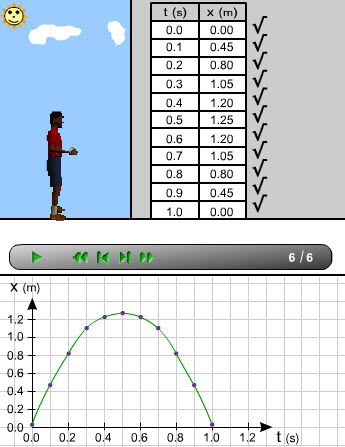Galileo
| One of the towering figures in science over the past 1000 years is Galileo Galilei (1564-1642). Galileo was a complex blend of brilliant scientist, shrewd entrepreneur and gifted writer. He could be rude and argumentative and probably did not suffer from "low self-esteem"! He was a faithful Catholic and he was very ambitious. He also lived in a time of immense intellectual activity. The Reformation was well underway in Northern Europe (and the Counter-reformation was well under way in Italy and southern Europe). Galileo's contemporaries included Elizabeth I of England, Rembrandt, Shakespeare and Milton. His scientific peers included Bacon, Brahe and Kepler. Galileo also lived on the cusp of two world views. He was born into the Medieval World and could be considered the last and greatest Medieval scientist. Yet his discoveries helped usher in the world of Newton who was born in the year of Galileo's death and which within a generation swept aside much of the old Medieval world view. | 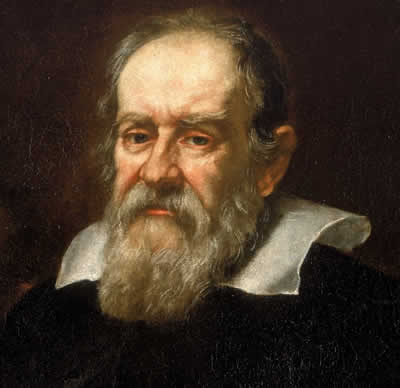 |
| Figure 4.21 Galileo Galilei (Justus Sustermans 1636. National Maritime Museum, Greenwich, London. image in public domain) |
Timeline of Important Events
- 1543-63 Council of Trent: established criteria for interpreting scripture
- Galileo born in Pisa, 1564.
- 1585: Galileo leaves University of Pisa without a degree - began private tutoring
- 1589: Galileo became lecturer in Mathematics at University of Pisa
- 1598: Invents the military compass, Galileo was busy with theories of motion and ballistics. Was on the military pay roll.
- 1600: Burning at the stake of Giordanno Bruno for holding heretical views including Copernicanism
- 1600: Professor at the University of Padua: rich, well regarded as a preeminent scholar.
- 1600-10: His most profound work on motion and falling bodies
- 1610: Built his first telescope and began his astronomical observations culminating in the publication of Sidereus Nuncius.
- 1613: Letter to Castelli in which he discusses his growing acceptance of the Copernican Model
- 1615: Letter to Grand Duchess Christina in which he eloquently defends the Copernican Model and the relationship between Science and Scripture
- 1616: Bellarmine is put "on the case" to investigate growing concern over Galileo's teachings
- 1616: Copernicanism branded a heresy
- 1616: Galileo put under censure - forbidden to teach, discuss or opine on the Copernican view.
- 1620 Sunspot controversy in which Galileo refused to acknowledge work done by his Jesuit contemporaries
- 1632: Publication of The Dialogue Concerning the Two Chief World Systems
- 1633: Galileo appears before the inquisition
- 1633-42: Lives rest of life under house arrest

Galileo and the Birth of Modern Science
Between 1590 and 1610 Galileo conducted many critical studies on the science of "motion" or kinematics. It was during this time that Galileo initiated two essential changes in how we have come to view the world:
The Rise of Experiment
While humans have always "experimented" and the rise of craft knowledge during the middle ages was built on experimentation, Galileo was one of the first to develop systematic approaches to experimentation and how to derive knowledge from experiment. A common philosophical bias of the day (going back as far a Plato and Aristotle) was that because the human senses were easily misled, "pure" knowledge could not be achieved by looking at the world (ie: experiment) - it could only come through contemplation. Galileo subtly changed the "rules" by claiming that useful (not "pure") knowledge about the world could be obtained by careful "looking" - that is - by experiment.
The Rise of Mathematics
Although Kepler's 3rd Law emerged at about this time we can attribute to Galileo the first systematic use of mathematics to describe the nature of the world. In his famous treatise of 1623 - The Assayer, Galileo writes:
“Philosophy [i.e., physics] is written in this grand book--I mean the universe--which stands continually open to our gaze, but it cannot be understood unless one first learns to comprehend the language and interpret the characters in which it is written. It is written in the language of mathematics, and its characters are triangles, circles, and other geometrical figures, without which it is humanly impossible to understand a single word of it; without these, one is wandering around in a dark labyrinth.” Galileo Galilei, Il Saggiatore (The Assayer, 1623)
Galileo had discovered as early as 1599 "The Law of Falling Bodies". In simple terms this is a mathematical formula that relates how far a body falls as a function of the time falling.
Experiment and mathematics, when combined, produce modern science and also radically transforms astronomy.
The Spy Glass, Sidereus Nuncius and the Heavens Unlocked
 |
During Galileo's formative years at Pisa and later Padua he became acquainted with the work of Copernicus and more and more convinced that this was the correct explanation of how the heavens worked. When word reached Galileo in summer 1609 of the curious invention by a Dutch optician - the "Spy Glass" he immediately grasped how it worked and built his own! Beginning in the fall of 1609 Galileo turned his telescope to the Moon, Venus, Jupiter, and the stars beyond. It was a transformative experience for Galileo and humanity. Sidereus Nuncius (The Starry Messenger) was published in 1610 and in this very short and readable book Galileo astounds the world with descriptions and drawings of the rough, mountainous face of the moon, phases of Venus, moons around Jupiter and countless stars hitherto unseen by the naked eye. Sidereus Nuncius became an instant "best seller". |
| Figure 4.23 A replica of Galileo's first telescope (Science Museum/Science & Society Picture Library, image number 10315150) |
Finally, in 1613 and then again in 1615 in a pair of "open-letters" Galileo publicly proclaimed his support for the Copernican Model. Thus began one of the most complex and famous episodes in the history of science.

Arguments Against "Copernicanism"
If the earth moves (rotates and orbits) then- why do we not feel the motion?
- how can something as large as the earth spin or move and keep on moving?
- how do we reconcile Joshua
10 "sun stand thou still upon Gibeon" with the idea of the earth moving
and not the sun?

- what clear evidence can you offer that the earth does, in fact move?
- the earth is moving why do we not see "parallactic shift" of the stars during the year?
What was at Stake:
- the authority of church in interpreting "truth" (see the "closer look" section above)
- the intricate, inter-related cosmology of Aristotelianism which encompassed much more than just planetary motion.
Galileo's Evidence:
The Moon: The rough, cratered texture of the Moon helped convince Galileo that the Moon was essentially the same kind of body as the Earth. In the Aristotelian model the Moon, by virtue of being in one of the higher "spheres" was considered to be at a higher level of perfection. Galileo's observations and drawings suggest that it was very similar to the Earth with mountains and seas (the lunar maria). His drawings of the moon challenged Aristotelian order and captivated readers. Figure 4.24 shows an image taken through a small telescope and similar to what Galileo would have seen. Some of the drawings from Sidereus Nuncius are shown as an inset. |
 |
|
| Figure 4.24 Composite image of what the moon looks like through a small telescope and some of Galileo's drawings of what he saw. | ||
The Sun and Sunspots Galileo's discovery of sunspots was important for two reasons:
Sunspots also had a "chilling" effect on the Galileo affair. For reasons that still elude historians, Galileo refused to share credit for the discovery of sunspots with a number of Jesuit astronomers. In so doing he isolated people who could have become advocates on his behalf with the papacy. |
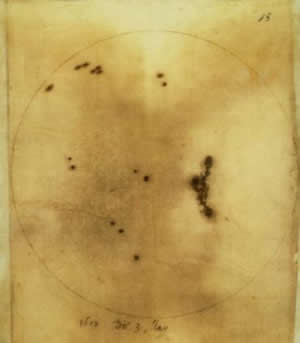 |
|
| Figure 4.25 One of Galileo's drawings of sunspots | ||
Venus The planet Venus has phases very similar to the moon. This is actually very compelling evidence for the Copernican model and virtually impossible to explain using the Ptolemaic model. Figure 4.26 shows Venus much as it would appear through a small telescope. In this image it is in a waxing gibbous phase. |
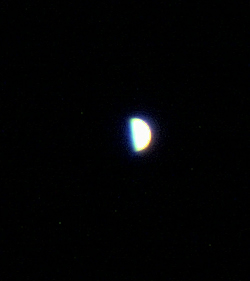 |
|
|
Figure 4.26 Venus through a small telescope shows phases very similar to those of the Moon. | |
Jupiter It was observing Jupiter's moons that convinced Galileo that he had "proof" of the Copernican model. Here was clear evidence that there were objects that did not revolve around the Earth! Figures 4.26 a and b show what Galileo would have seen and how it appeared in his notes. |
 |
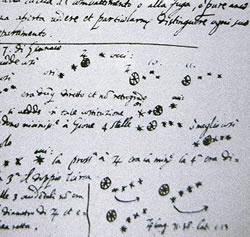 |
| Figure 4.26a,b a)Three of Jupiter's "Galilean" moons as seen through a small telescope; b) Part of Galileo's notebook showing the moons of Jupiter and their motion from night to night. | ||
The Stars When Galileo trained his telescope on the stars he saw a myriad of faint stars not visible to the un-aided eye. Under magnification the stars remained points of light which suggested to Galileo that they were very far away (and perhaps explaining the failure to exhibit parallactic shift during the year). Figure 4.27 shows the Beehive Cluster much as it appears in a pair of binoculars or in a small telescope. |
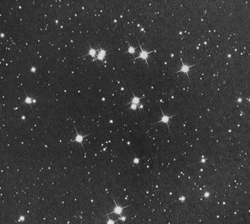 |
|
| Figure 4.27 The "Bee Hive" or Praesepe cluster | ||
The Collision between Galileo and the Church
- On one hand Galileo isolated the academic community by "poking fun" and writing in Italian rather than the scholarly Latin.
- On the other, Galileo represented a challenge to how scripture should be read and, when dispute arises, how dispute should be settled (Council of Trent)
However -
In fact, Galileo's actual crime had little to do with science and faith. Rather, it was his alleged failure to comply with a Papal order not to expound on the Copernican system.Painting this clash as Science against Faith is a monumental distortion that has been a disservice to students for centuries!
Had Galileo agreed that the Copernican theory was a hypothesis and not an exact description of nature he would have avoided the clash with the church. He refused.
Was he a zealous Copernican or did he have another motive...? We will probably never know the answer to this question. It is reasonable, however, to conclude that part of the "Galileo Affair" had to do with changing the rules on how science would operate in the future. The Vatican challenged Galileo to provide proof for the Copernican Model (perhaps knowing he could not comply). Galileo, however offered persuasion and plausibility rather than rigorous proof. Modern science began to emerge with this subtle shift away from proof and into the development of persuasive and coherent arguments designed to explain the physical world. Galileo also elevated the role of empiricism in science. Rather than relying on theories of how the world "ought-to-be" (circle dogma for example), one's theory had to conform to observations.
The Impact that Galileo had and
continues to have on Culture
By the end of his life Galileo had become a cultural force. His introduction of the "spy-glass" had transformed how we see the world and its influences could be found in the paintings of the day: For example, look carefully at Lodovico Cigoli's Assumption of the Virgin (1612) shown in Figure 4.28. The Moon upon which the Virgin stands looks very much as Galileo drew it in Sidereus Nuncius. In his later years, while under house arrest, Galileo received many famous guests including the British philosopher Thomas Hobbes. For some he came to represent the struggle for truth and academic freedom to pursue truth. Galileo has and continues to inspire poets and playwrights the likes of Bertold Brecht (The Life of Galileo) Galileo lived at a crucial historical crossroad. He was born into the medieval world in which everything was governed by God and had a prescribed place and purpose In his death he left a much different world, one in which (eventually) mechanistic ideas would eventually operate (or seem to) independently of deity. |
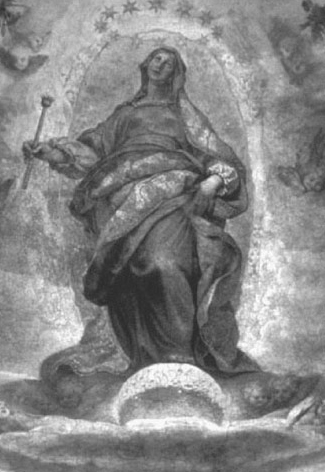 |
| Figure 4.28 The Assumption of the Virgin by Lodovico Cigoli (1612) |

To understand some of the contributions made by Galileo and how they changed astronomy

- l



![]()

